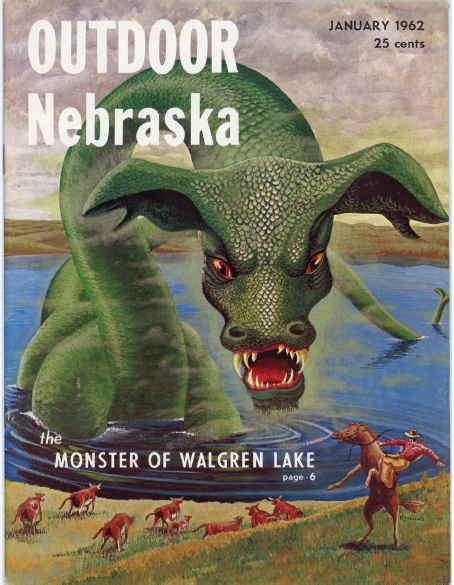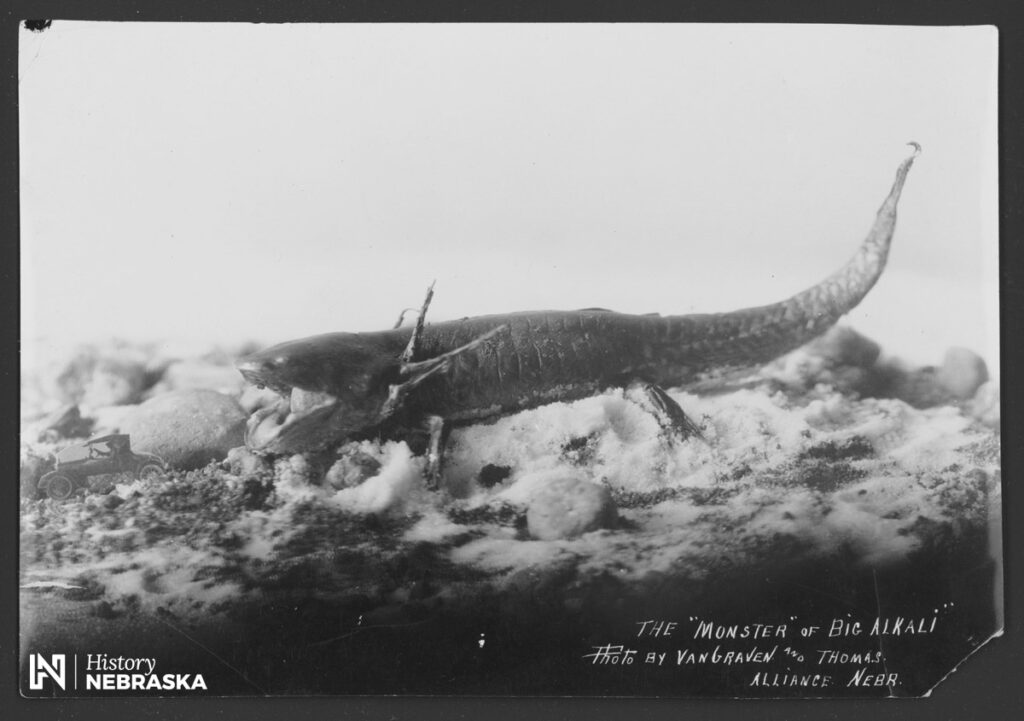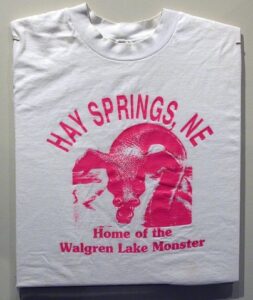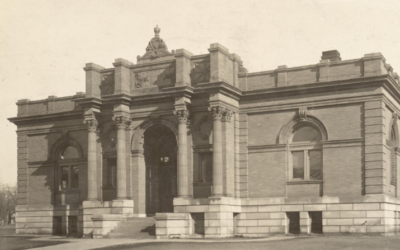
January 1962 edition of Outdoor Nebraska
Swimmers in Nebraska ponds, lakes, and waterways face typical summer hazards such as sunburns, snapping turtles, and thunderstorms, but at least they don’t have to worry about monsters. Or do they?
Lake Walgren, a 50-acre lake located in Sheridan County near Hay Springs, has a storied history of harboring Nebraska’s best-known lake monster. The Lake Walgren monster has been variously described as a very large catfish, a large mudpuppy, and even as a giant, horned alligator-like beast that devours livestock and waterfowl. Its size has varied from “the size of a yearling steer” to “2 ft broad and 10 or 12 ft long.” One report said it spouted water like a whale.
The first official reports appeared in the Hay Springs News in 1921. An article on September 16 was headlined, “If It Isn’t a Whale It’s a Whaler of An Animal.” A subsequent article on October 21 discussed a proposed seining to catch the monster but “game officials did not think they had a sein [sic] large enough to hold him so the undertaking has been delayed indefinitely.” The August 11, 1922, issue reported “The Huge Water Animal Again Seen on Surface.” The Omaha World-Herald picked the story up in 1923 when a man named J. A. Johnson claimed he and his friends saw a water monster “forty feet long, dull gray/brown in color with a horn-like object between its eyes and nostrils. They said it looked similar to an alligator but was bigger and heavier than an alligator. When the creature noticed the men, it emitted a ‘dreadful roar,’ thrashed its tail about and then dove under the water.”
Following the World–Herald’s coverage the story was picked up by several other newspapers, including the London Times: “By far the most vivid picture of the actions and features of a medieval monster which for three years has been terrifying the natives of the vicinity of Alkali Lake near the small town of Hay Springs, Nebraska, U.S.A., was received by our Omaha, Nebraska correspondent, today” (Folklore Pamphlet).
But how did the London Times hear about this story? The same way the other newspapers did. The story was fed to them by Nebraskan John G. Maher, whose skill at creating hoaxes was nearly as legendary as the hoaxes themselves. Historian Louise Pound writes about his schemes in a December 1952 Nebraska History article titled “The John G. Maher Hoaxes.”
Maher was a successful newspaperman, businessman, politician, and veteran. Most of his success as a newspaperman resulted from his habit of creating and maintaining sensational stories. He created a fake “petrified man” out of cement, using a Buffalo Soldier from Fort Robinson as a model, and then planted it for archeologists to find near Chadron. The “man” was pronounced genuine and exhibited throughout the country. Maher also sank bags of soda in boiling springs near Chadron to produce “soda springs” with healing properties, and convinced some western Nebraskans that the British navy was traveling up the Mississippi and Missouri Rivers to enact vengeance on the Irish immigrants for their support of the Irish Republic.
The Walgren Lake monster is Maher’s longest-lasting hoax. Some parts of the story have faded while others have grown. Pound’s article includes a 1925 telegram from the Omaha World-Herald that reads: “Have a tip that Bruce Heweitt and J. Mayes of Rushville solved the Hay Springs Lake mystery by finding a mermaid frozen in ice of the lake. Wire 300 word story if above is correct, also rush photo of mermaid.” Even though the mermaid idea didn’t stick and the giant sea serpent flourished, Maher was still finding ways to keep this story alive three years after the first story appeared in the Hay Springs News.
The story got further coverage in Mari Sandoz’s 1935 biography of her father, Old Jules:
Alkali Lake, near Hay Springs, where the early sky pilots dipped their converts, was inhabited by a sea monster – with a head like an oil barrel, shiny black in the moonlight. Some thought it a survival of the coal age. But Johnny Burrows and other fundamentalists of the Flats knew better. The same devil that scattered the fossil bones over the earth to confound those of little faith could plant a sea monster among the sinners. ‘Real estate must be moving slow on the Flats,’ Jules laughed. When Andy came in, he asked if he had seen anything of the monster. The little grub-line rider took the jew’s harp from between his leathery lips. ‘No, cain’t say’s I has, but I seen lots o’ the stuff them fellahs as sees ‘im drinks.’

The “Monster” of Big Alkali Lake, later known as Walgren Lake.
The legend continued to grow even after purported eyewitness accounts dwindled. In July 1938 the Federal Writers’ Project in Nebraska published a version of the monster story in Number Thirteen of their monthly Tall Tales publication:
Since long before the time of Old Jules, a monster sea-serpent has inhabited Alkali (Walgren) Lake a few miles southeast of Hay Springs. He is one of the few inland sea serpents in the world. Sometime down through the years, possibly to distinguish him from other sea serpents known for their phenomenal performances, he acquired the name of Giganticus Brutervious. So formidable is Giganticus that when he comes to the surface of the water, the earth trembles, and the skies cloud over. Those who have been brave enough and strong enough to endure a glance at him say that his flashing green eyes spit fire, that with a head like a huge oil barrel, he looks like something one sees in a very bad dream, and that the least movement of his big pointed ears causes a tempest on the lake. As he rears and flips his powerful tail, the farmers become seasick for miles around. When he comes ashore to devour his daily ration of a dozen calves, a mist arises so thick that travelers cannot make their way through it, and his flashing eyes color the mist a murky green. The gnashing of his teeth sounds like clap after clap of thunder.
This account also tells of more developed plans to catch the monster by dragging the lake: “The townspeople estimated the cost of dragging the lake at approximately $1,000. The landowners however asked $4000 for a three month’s lease of the lake and adjacent land, and the Investigation Association would not agree to this price.”
With this important level of mystery remaining, the legend was re-told in the cover story of the January 1962 issue of Outdoor Nebraska (as NEBRASKAland magazine was then known). The article gave the monster supernatural powers as well as a terrifying physical presence. One of his abilities was to influence the weather. Naturally, his victims were not Nebraskans, but “eastern innocents”:
One group of eastern innocents was traveling south out of Hay Springs when, without any cause, the clear sky clouded over and the heavens rumbled. Before the travelers knew it, they were surrounded by a mist so thick they couldn’t see where they were going. They decided the best thing to do would be get back to Hay Springs. Bu the mist began to get green and the earth was rolling beneath them and their car was bouncing along at a terrible speed. When they finally escaped the horrible shroud, the dudes discovered that they had been bounced all the way to Valentine. Of course, this might have been exaggerated. They probably got to Gordon.
This article even tries to explain why sightings of Gigantus had dwindled since the 1920s:
Then, an especially intelligent native came up with the idea. If they just ignored Gigantus, maybe he would go away. Hay Springers followed this plan, and no matter what trick the monster tried, it didn’t attract any attention. Either bored with life or disgusted that he couldn’t create too much of a stir any more, Giganticus stopped making appearances. Just what did happen to him isn’t known. Some think he has gone into some subterranean retreat. Others think that perhaps he has deserted the lake altogether and is now residing in Scotland.
But “Hay Springers” have never forgotten their monster. The Hay Springs Centennial Committee in 1985 created commemorative Lake Walgren monster t-shirts and buttons to promote their event. According to the NSHS website, they used the description of local resident J. A. Johnson in 1923 for their illustration, but most of their designs have removed the horn-like object between its eyes and nostrils that Johnson described. The NSHS website says, “Some have speculated that Johnson actually saw an unusually large beaver.”

Promotional t-shirt sold by the Hay Springs Centennial Committee in 1985.
While the first published reports of monster sightings started in the 1920s, the legacy of the Walgren Lake monster continues today. The most remarkable part of this story might not be the monster itself, but the enduring legacy of a monster story and the collaborative ability of Nebraskans to keep a hoax going for the better part of a century. And if it’s not a hoax? Make sure you apply monster repellent along with your sunblock and bug spray this summer.
Sources/Further Reading: Federal Writers’ Project in Nebraska. “The Mysterious Lake Monster.” Tall Tales. No. 13, July 1938. Web. “Monster Makes Big Splash in Small Lake.” Nebraska State Historical Society. Web. Pound, Louise. “The John G. Maher Hoaxes.” Nebraska History. Dec. 1952. 23.4. Print. Wagner, Greg. “Throwback Thursday: Monster!” NEBRASKAland. 3 Apr. 2014. Web.



